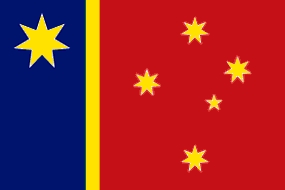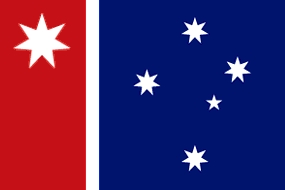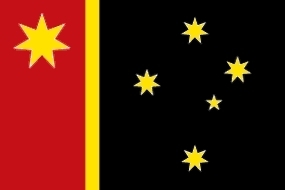
Ensigns
Australia currently uses several ensigns in various capacities. She uses the Merchant Ensign for civilian ships, the Civil Air Ensign for civil air facilities (e.g. airports, commercial planes when landed), the Naval Ensign for - surprisingly enough - the Royal Australian Navy, and the Royal Australian Air Force Ensign for the RAAF. A change in the national flag would presumably mean that all of the flags would have to be changed, and so I have designed some new ensigns. As with most Australian ensigns at the moment, these ensigns' designs are identical to those of the national flag, but the colours have been changed and/or switched around.
The Prime Minister's Flag - Here, I have taken the alternative design for the national flag; red at the hoist, gold in the fimbriation and stars, blue at the fly. As well as being a combination of Aboriginal and British symbolism, Australia's heraldic colours of blue and gold are present. These can also represent Europe as a whole. The three colours are also present in several Asian flags. As well as symbolising the ethnic groups the Prime Minister governs, red symbolises the land he governs. Blue symbolises the freedoms of the Australian people, and gold their prosperity, both of which the Prime Minister must guard.

Merchant Ensign - Here, I have simply switched the red and the black in my idea for the national flag. This design thus includes Aboriginal and British symbolism, and resembles the current Merchant Ensign (identical to the current national flag, but with a red background rather than a blue one). There is also a more direct meaning; red stands for the land which ships sail to or from, white for the stars (which men once navigated by), and black for the sky and the sea (presumably at night).

Civil Air Ensign - Here, I have reversed the blue and red of the Prime Minister's Flag. As well as symbolising British and Aboriginal heritage, blue symbolises the sky, gold the stars and sun, and red the land from which the planes depart (or on which they land).

Naval Ensign - Here, I have used red for the stripe at the hoist, white for the fimbriation and stars, and blue for the remainder. These are the colours of the Union Flag (and of the modern-day Dutch tricolour - after all, the Dutch discovered Australia in the seventeenth century, calling it "New Holland"); I considered it appropriate to use them in acknowledgement of the British and Dutch naval traditions, which to a great extent were passed on to Australia. The direct meaning is similar to that of the Merchant Ensign.

Royal Australian Air Force Ensign - I have used red at the hoist, gold for the fimbriation and stars, and black for the remainder. These are the colours of the Aboriginal flag; as I have used the colours of the Union Jack on their own in the Naval Ensign, I felt it appropriate to include one flag with purely Aboriginal colours. The red symbolises the land the RAAF defends (and takes off from), the gold symbolises the stars and the sun, and the black symbolises the (night) sky.

It remains to be said that all these designs can be switched around if desired. For example, the Prime Minister's Flag could become the national flag; the symbolism would be perfectly acceptable. The Naval Ensign could become the Prime Minister's Flag, as the Australian system of government ultimately comes from the British tradition of parliamentary democracy.